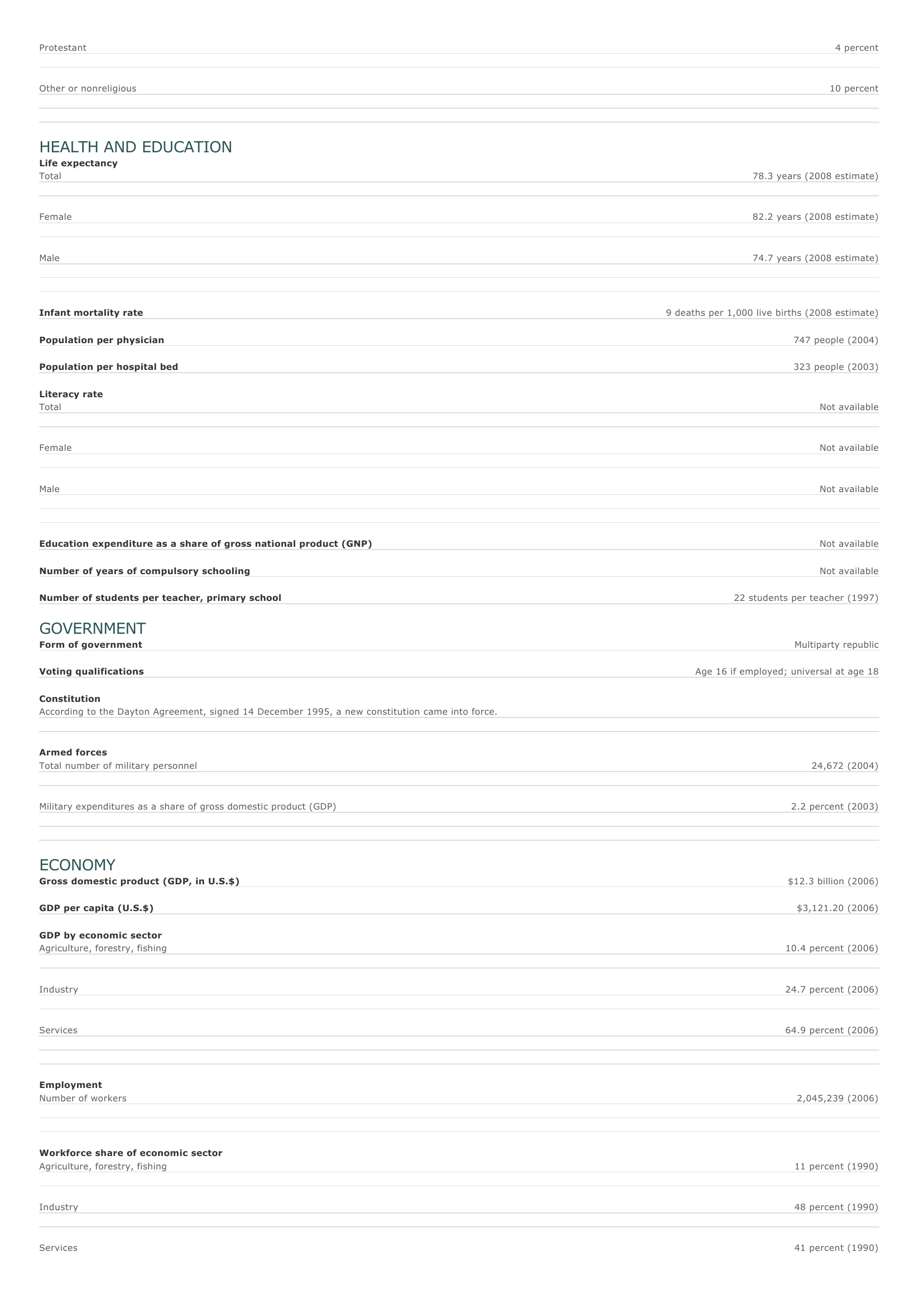Bosnia and Herzegovina Facts and Figures. BASIC FACTS Official name Capital Area Bosnia and Herzegovina Sarajevo 51,129 sq km 19,741 sq mi PEOPLE Population 4,590,310 (2008 estimate) Population growth Population growth rate 0.67 percent (2008 estimate) Projected population in 2025 4,535,296 (2025 estimate) Projected population in 2050 3,891,669 (2050 estimate) Population density 90 persons per sq km (2008 estimate) 233 persons per sq mi (2008 estimate) Urban/rural distribution Share urban 45 percent (2005 estimate) Share rural 55 percent (2005 estimate) Largest cities, with population Sarajevo 579,000 (2003 estimate) Tuzla 133,861 (2003 estimate) Zenica 128,495 (2003 estimate) Novi Grad 116,832 (2003 estimate) Mostar 105,448 (2003 estimate) Ethnic groups (2000) Bosniak 48 percent Serbian 37 percent Croatian 14 percent Others Languages Bosnian, Croatian and Serbian (official) O ther 1 percent 99 percent 1 percent Religious affiliations Muslim 40 percent Orthodox Christian 31 percent Roman Catholic 15 percent Protestant Other or nonreligious 4 percent 10 percent HEALTH AND EDUCATION Life expectancy Total 78.3 years (2008 estimate) Female 82.2 years (2008 estimate) Male 74.7 years (2008 estimate) Infant mortality rate 9 deaths per 1,000 live births (2008 estimate) Population per physician 747 people (2004) Population per hospital bed 323 people (2003) Literacy rate Total Not available Female Not available Male Not available Education expenditure as a share of gross national product (GNP) Not available Number of years of compulsory schooling Not available Number of students per teacher, primary school 22 students per teacher (1997) GOVERNMENT Form of government Multiparty republic Voting qualifications Age 16 if employed; universal at age 18 Constitution According to the Dayton Agreement, signed 14 December 1995, a new constitution came into force. Armed forces Total number of military personnel Military expenditures as a share of gross domestic product (GDP) 24,672 (2004) 2.2 percent (2003) ECONOMY Gross domestic product (GDP, in U.S.$) GDP per capita (U.S.$) $12.3 billion (2006) $3,121.20 (2006) GDP by economic sector Agriculture, forestry, fishing 10.4 percent (2006) I ndustry 24.7 percent (2006) Services 64.9 percent (2006) Employment Number of workers 2,045,239 (2006) Workforce share of economic sector Agriculture, forestry, fishing 11 percent (1990) I ndustry 48 percent (1990) Services 41 percent (1990) Unemployment rate Not available National budget (U.S.$) Total revenue 4,877 million (2006) Total expenditure 4,379 million (2006) Monetary unit 1 convertible marka, consisting of 100 convertible pfenniga. Croatian kuna, Bosnian dinar, and some other former currencies are still in use. Major trade partners for exports Italy, Croatia, Germany, Austria, Slovenia Major trade partners for imports Croatia, Slovenia, Germany, Italy, Hungary ENERGY, COMMUNICATIONS, AND TRANSPORTATION Electricity production Electricity from thermal sources 49.57 percent (2003 estimate) Electricity from hydroelectric sources 50.43 percent (2003 estimate) Electricity from nuclear sources 0 percent (2003 estimate) Electricity from geothermal, solar, and wind sources 0 percent (2003 estimate) Number of radios per 1,000 people 270 (1999 estimate) Number of telephones per 1,000 people 248 (2005) Number of televisions per 1,000 people 123 (2000 estimate) Number of Internet hosts per 10,000 people Daily newspaper circulation per 1,000 people Number of motor vehicles per 1,000 people Paved road as a share of total roads 19 (2003) 146 (1995 estimate) 48 (1997) 52 percent (1999) SOURCES Basic Facts and People sections Area data are from the statistical bureaus of individual countries. Population, population growth rate, and population projections are from the United States Census Bureau, International Programs Center, International Data Base (IDB) (www.census.gov). Urban and rural population data are from the Food and Agriculture Organization (FAO) of the United Nations (UN), FAOSTAT database (www.fao.org). Largest cities population data and political divisions data are from the statistical bureaus of individual countries. Ethnic divisions and religion data are largely from the latest Central Intelligence Agency (CIA) World Factbook and from various country censuses and reports. Language data are largely from the Ethnologue, Languages of the World, Summer Institute of Linguistics International (www.sil.org). Health and Education section Life expectancy and infant mortality data are from the United States Census Bureau, International Programs Center, International database (IDB) (www.census.gov). Population per physician and population per hospital bed data are from the World Health Organization (WHO) (www.who.int). Education data are from the United Nations Educational, Scientific and Cultural Organization (UNESCO) database (www.unesco.org). Government section Government, independence, legislature, constitution, highest court, and voting qualifications data are largely from various government Web sites, the latest Europa World Yearbook, and the latest Central Intelligence Agency (CIA) World Factbook. The armed forces data is from Military Balance. Economy section Gross domestic product (GDP), GDP per capita, GDP by economic sectors, employment, and national budget data are from the World Bank database (www.worldbank.org). Monetary unit, agriculture, mining, manufacturing, exports, imports, and major trade partner information is from the statistical bureaus of individual countries, latest Europa World Yearbook, and various United Nations and International Monetary Fund (IMF) publications. Energy, Communication, and Transportation section Electricity information is from the Energy Information Administration (EIA) database (www.eia.doe.gov). Radio, telephone, television, and newspaper information is from the United Nations Educational, Scientific and Cultural Organization (UNESCO) database (www.unesco.org). Internet hosts, motor vehicles, and road data are from the World Bank database (www.worldbank.org). Note Figures may not total 100 percent due to rounding. Microsoft ® Encarta ® 2009. © 1993-2008 Microsoft Corporation. All rights reserved. Microsoft ® Encarta ® 2009. © 1993-2008 Microsoft Corporation. All rights reserved.












